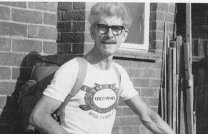
Author: Michael Harverson

Arthur Smith worked at the cutting edge of modern technology in the aircraft industry, but has always been happiest when out in the countryside. “Natural history is my main motivation in life. It was through a field study that I became interested in windmills. I found little had been written about them, or where they were, so I began to find out.” During the 1970s and 1980s Arthur travelled over 20,000 miles, half of them by bicycle, meticulously plotting, photographing and recording windmills. His completed surveys of the surviving windmills of a dozen counties include 750 mills, all visited by himself.
He takes great care in all his work, symbolised by the impeccable calligraphy of his handwriting. By financing the publication of the series himself, he ensured that everything was done to his satisfaction. But he also pointed out, “There’s no question of making a profit. I just make enough to cover the printing costs of the next book. I do it simply because I enjoy it.”
On his cycling trips Arthur has been known to bivouac in woods, with only a sleeping bag for protection from the elements. As he explained, “I like to be my own boss and I like the countryside. It’s not always that comfortable though, on the Fens, where there are no trees. With the rats scurrying around, I hardly slept at all.”
As he recalled on retirement in 1982, “Some people of my age tell me I should slow down, but just because you reach a certain age doesn’t mean you have to stop doing things. I don’t feel old.” Physical exertion and exercise meant that he kept as fit as men half his age. Until very recently, he seemed to thrive on pushing his thin wiry frame towards new goals. Every day of his working life he cycled the 25 miles return trip from his home in Stevenage to Hatfield. “Even if the weather looked really bad, I always set out and I always made it. In thirty years I only took the train once.” After retirement, he was a frequent visitor at Cromer post mill, cycling the ten-mile round trip from home. With his camera, he recorded the restoration work on this last remaining Hertfordshire postmill in the 1990s, a project close to his heart and now exactly chronicled for posterity in his collection.
After 20 years of active involvement in judo, with a brown belt (one grade below black), Arthur turned to running four or five miles every lunchtime with some of his colleagues. This led to competing in marathons and half-marathons at an age when most men would rather put their feet up than down. In 1999 he took part in his fifth London Marathon at the age of 75.
Arthur Smith grew up near Ampthill in Bedfordshire and his earliest recollection in life is being stung by a wasp at the age of three. This first painful experience with nature didn’t put him off, and over the years he has studied flowers, birds, fossils and astronomy, always getting out into the country at every opportunity. His own precise methodical character was developed by these experiences. “I don’t call myself an author,” he says modestly, “but I’ve always kept nature notebooks or a diary. Anything I saw I recorded, using photography, paintings or drawings. I’m not content with seeing it, I just have to write it down.”
Two major influences in his life have been music and aeroplanes, interests that go back to his boyhood. He won a scholarship to the New College Choir School in Oxford, where he became head chorister. “Music is part of my life, and if somebody asked me if I’d like to do anything in life again, it would be singing treble in a choir. It was a wonderful experience.”
The war interrupted his education, and he volunteered for the R.A.F., flying in Halifax bombers. He survived a bad crash in which two of his colleagues were killed. “It was a peculiar life, but I’ve never experienced camaraderie like it. We did everything together and I’m still in touch with three of the remaining crew.” After the war he became a design draughtsman and worked for British Aerospace on projects right through from the Comet to the BA 146.
Arthur, who was known to some of his colleagues at work as “Mr Windmills”, admits to being something of a magpie. For years his house was full of records, photographs, books and mementoes, with one whole room devoted to windmills. This is the collection that he has now donated to the Mills Archive, for future molinologists to study and enjoy. Its careful cataloguing by Arthur himself means that the task of accessioning and preparing the collection for general availability is child’s play compared to the work needed by other distinguished collections that have been passed to the Mills Archive. His wife Joy, whom he first met at a promenade concert at the Albert Hall, has put up with living in this magpie’s nest while bringing up the couple’s three daughters and a son, but can now at last swing the proverbial cat in her sitting room again. (Not that Joy would ever dream of swinging her much-loved moggie anywhere!)
“Perhaps I’m a bit eccentric but so are a lot of people in certain ways. It really doesn’t matter what others think. I find so many things to interest me I could make a hobby out of any subject. I’ve never been bored in my life.” Now that the long windmill chapter of his life is over, Arthur is turning his attention to dragonflies, as a Hertfordshire county recorder.
Arthur C Smith died 18 June, 2013.

Based on a typescript of an article by Ian Prosser from the Sunday Post, June 23rd 1982 (ACSC-08473)
Related content
- Toadstools to Windmills
- The windmill man
- Arthur C Smith Collection
- Library catalogue: Smith, Arthur C
